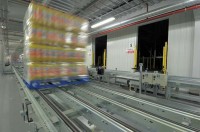 Handling the output of today’s bottling or canning plant presents the materials handling industry with one of its most demanding challenges. High volumes of bulk products produced in some cases round the clock require advanced automated systems to act as an efficient buffer between unceasing production and less predictable demand. Keith Edmonds, Head of Sales at integrated materials handling solutions provider Logistex, considers what types of systems and equipment are best suited to the industry and what the potential buyer should look for in a supplier.
Handling the output of today’s bottling or canning plant presents the materials handling industry with one of its most demanding challenges. High volumes of bulk products produced in some cases round the clock require advanced automated systems to act as an efficient buffer between unceasing production and less predictable demand. Keith Edmonds, Head of Sales at integrated materials handling solutions provider Logistex, considers what types of systems and equipment are best suited to the industry and what the potential buyer should look for in a supplier.
The food and drinks industry – and most significantly high volume producers of products in bottles, cans and other retail-sized containers – generally need materials handling systems able to handle volumes and throughputs in excess of most other sectors. Continuous production lines can generate thousands of pallets of finished goods each day, which may not be required for immediate shipment. Factors such as seasonal demands, promotions and abrupt weather changes can all affect storage volumes and the need to pick and dispatch orders with minimum delay.
While some companies outsource bulk storage to a third party to save on-site manufacturing space, such a policy may incur the cost of additional handling, excess storage and less control over stocks and shipments.
From production to storage
The prime consideration is to find a method of taking completed pallets away from the production zone as soon as they are ready to avoid a backlog that could disrupt manufacturing. High speed powered automated conveyors of the type Logistex has installed in Coca Cola bottling plants can handle close to 300 pallets per hour, as well as using transfer cars and vertical transfer devices to move pallets in whatever direction is required. They eliminate the need for fork trucks which require considerable space and a team of operators. In addition conveyors can be installed above floor level, releasing valuable floor space for other purposes.
Space efficient storage and picking systems
Modern high bay, narrow aisle pallet storage systems provide the most efficient means of bulk storage with fast picking access. Automated stacker cranes can take pallets directly from feed conveyors and place them as required in the store. With aisles little over 1.50m wide they make maximum use of cube space, and can work around the clock with minimum lighting or heating required – a considerable cost saving.
The same stacker cranes automatically locate, select and pick pallets as required and take them directly to the dispatch zone for shipment.
Stock and control management software
With modern integrated, automated materials handling systems, pallet locations and movements, stock levels, order picks and other essential information are all controlled by software packages such as Logistex’s own Warehouse System (LWS) that can interface with the client’s own software and production control processes. This ensures a seamless link between manufacturing, storage and dispatch, providing real time management data and control at every stage.
What automated systems can achieve
As in any supplier selection process, the buyer should look for a company with the experience and all-round expertise to project-manage the entire assignment from start to finish. As a 4th party integrator, able to select the most suitable equipment and systems for each task, Logistex has a track record going back half a century and includes Coca Cola among its clients in this sector.
Two recent projects illustrate the levels of performance achievable in bottling and related applications. The company designed and installed a new automated high-bay rack-clad warehouse in Romania for Coca-Cola Hellenic Bottling Company (CCHBC), including a 30m high pallet rack store for nearly 35,000 pallets. The new system replaces the former manual handling process and will enable the client to meet growth in the Romanian market and increase pallet handling capacity by 33%.
Two automated powered conveyors – installed 3.5m above floor level to provide maximum usable floor space – bring palletised finished goods from six production line feeds into the warehouse, at up to 290 pallets per hour. Coupled with the stock consolidation into a single storage facility, the project has considerably reduced the company’s carbon footprint. Pallet movements, stock levels and other essential information are managed by the Logistex Warehouse System (LWS) interfaced directly with CCHBC’s existing SAP ERP (Enterprise Resource Planning) system, with pallet outfeed rates of up to 490 per hour.
Closer to home, a new automated materials handling system in Edmonton, London, for Coca Cola Enterprises has helped eliminated former double handling when shipping products off site to local warehouses and has released space for improved throughput, operational efficiencies and better stock management.
The 33m high clad rack building can accommodate 25,224 pallets and has the scope to accommodate increased production to reach growth targets. Linked to five bottling production lines handling mainly 500ml and 2 litre bottles of soft drinks for customers in London and South, the facility can receive 200 pallets and dispatch 300 pallets every hour.
The building has 12 aisles with fully automated storage and retrieval systems, each with 32m high, double deep pallet handling cranes. Five automated elevator units link the production lines to a high-level pallet system.
While such automated systems represent a considerable investment for any business, their ability to enable producers to manage stock and meet the demands of customers ranging from leading retailers so individual outlets mean that the ROI will be more than acceptable, with fast payback and a long and productive life.
Logistex
Enquiries to Keith Edmonds
Tel: 01536 480600




Comments are closed.